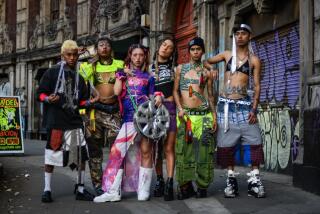Street, Surf Wear Compete but Don’t Meet at Expo
- Share via
On one side of San Diego Convention Center, the titans of the surf-wear industry spent the weekend trying to sell sun and fun. Bikini-clad models strutted down runways and champion surfers signed autographs.
On the other side, crowds of youths jammed around booths that hawked the baggiest of shorts and multicolored baseball caps meant to be worn backward. They shot pool or danced to loud rap music. Some carried the rebellious, inner-city look further by sporting tattoos or nipple rings.
These two extremes during the Action Sports Beach Expo once again highlighted the quandary facing the $1-billion surf-wear industry based largely in San Diego and Orange counties.
After spending years promoting “California lifestyle apparel” and a corresponding laid-back image, the hottest fashions nowadays are rooted in the look of the inner city and intended for customers who know next to nothing about the surf culture that spawned the fashions in the first place.
The chasm at the show was not accidental. Organizers reportedly received complaints last year about the incompatibility of mixing the music-pounding street-wear companies with the surfing-rooted firms. So this year, they separated the two.
An interesting dynamic was at work. The skateboarders and others favoring the street look pronounced the other side of the hall to be boring. “There was nothing there that interested me,” said skateboarder Greg Hodyna of San Luis Obispo, who dismissed it as “swimsuits and kids’ stuff.”
The leaders of established surf-wear companies like Redsand of Vista and Quiksilver of Costa Mesa questioned how much longer the street look would stay popular.
They also noted that unlike the more established beach-inspired companies, the new street-wear designers are mostly small start-up operations with questionable staying power.
“I don’t know how long this (street-wear fad) is going to last. You have got a ton of lines,” said Robert Lusitana, chief financial officer at Redsand, which made its name in more traditional designs of volleyball wear and men’s shorts and shirts.
Robert McKnight, president of Quiksilver, raised similar issues but said that the design influence of the new street look is already being felt. It has reintroduced bright colors and makes shorts baggy again, albeit not as baggy as some of the newest firms are designing. “It brings a lot of energy back,” he said.
Companies best positioned to take advantage of the changes are those with strong retail and business connections but with a willingness to experiment with the new look. Two of those, for instance, were Mossimo Inc. and Spot, both of Irvine. Both positioned their booths in hip-hop country.
Founder Mossimo Giannulli, shouting to be heard over the live rap artist performing over loudspeakers at the booth next door, said he made a “conscious effort not to be pigeonholed” into a particular look. He was debuting his line of casual shoes, which are made on a private label basis by Vans in Orange, and women’s apparel.
Said Spot President John Bernard, “We’re almost getting two separate industries here. . . . We want to be on the bridge.”
Just how the department- and specialty-store buyers felt about all this was not easy to discern. Vendors said most of the former were in short supply because of overlapping scheduling with with another convention, the Men’s Apparel Guild in California, in Las Vegas.
But it was clear that the surf wear-street wear split is having some profound effects at the retail level. Department stores that introduced surf wear to the masses over the past five years are now spurning it and buying street-inspired looks instead.
“It is partly because department stores don’t think it is hot any more, or as hot as it was,” said Glenn Wilk, a convention spokesman.
The changeover, however, has been a boon for the owners of surf shops. These beachfront retailers who began to feel neglected as the bigger surf-wear purveyors started concentrating on mass merchandisers are suddenly being lavished with attention again.
“A lot of companies are refocusing their energy in specialty shops,” Wilk said.
Jeff Kinney, who owns surf shops in San Diego and Bonsall, said the change is bringing him back to basics. Surf shops are catering more to surfers, not wanna-bes who simply want to capture the look.
“For the last two years, I said at my store, ‘We sell the sport of surfing.’ ” he said.
More to Read
Sign up for Essential California
The most important California stories and recommendations in your inbox every morning.
You may occasionally receive promotional content from the Los Angeles Times.










